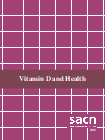Public Health England

Details
SACN reviewed the evidence on vitamin D and health to see if UK dietary recommendations, set in 1991, were still appropriate.
In a change to previous advice, SACN is now recommending:
- a reference nutrient intake (RNI) of 10 micrograms of vitamin D per day, throughout the year, for everyone in the general population aged 4 years and older
- an RNI of 10 micrograms of vitamin D per day for pregnant and lactating women and population groups at increased risk of vitamin D deficiency
- a safe intake of 8.5 to 10 micrograms per day for all infants from birth to 1 year of age
- a safe intake of 10 micrograms per day for children aged 1 to 4 years
The RNI and safe intakes were developed to ensure that the majority of the UK population has enough vitamin D to protect musculoskeletal health, all year round.
SACN did not take account of sunlight exposure in making recommendations because of the number and complexity of factors that affect skin synthesis of vitamin D.
The RNI and safe intakes refer to intake from all dietary sources:
- natural food sources
- fortified foods (including infant formula milk)
- supplements
They also refer to average intakes over a period of time, such as a week, and take account of day-to-day variations in intake.
You can view documents related to the consultation on the draft report. These documents include a substantial number of consultation comments received and SACNs responses.
The European Food Safety Authority (EFSA) published its Scientific Opinion on Dietary Reference Values for vitamin D. You can view the joint note by SACN and EFSA which explains why their respective recommendations are not directly comparable.

